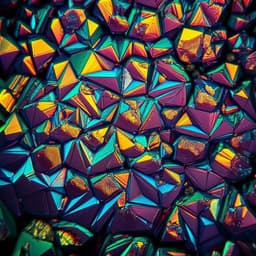
Engineering and Technology
Wafer-scale integration of two-dimensional perovskite oxides towards motion recognition
M. Deng, Z. Li, et al.
Discover how a team of researchers, including Ming Deng and Ziqing Li, have achieved wafer-scale integration of 2D perovskite oxide nanosheets, paving the way for high-performance photodetectors. Their innovative approach results in flexible devices with remarkable sensitivity and speed, perfect for advanced optoelectronic applications.
~3 min • Beginner • English
Introduction
Two-dimensional semiconductors enable advanced optoelectronic systems (machine vision, neuromorphic vision, in-sensor computing) due to tunable optical/electronic properties and heterogeneous integration. Two-dimensional perovskite oxides (e.g., Ca2Nb3O10, Sr2Nb3O10) offer wide-bandgap UV detection advantages and avoid instability/toxicity of halide perovskites, complementing the shortage of UV-capable 2D semiconductors. Despite promise, 2D perovskite oxides face two key obstacles: harsh synthesis impeding large-area, thickness-controlled films, and defect-induced persistent photoconductivity causing slow response and poor balance between responsivity and speed. Most prior efforts enhance single nanosheet/top-down devices, offering limited guidance for scalable applications. There is an urgent need for a strategy that simultaneously enables wafer-scale integration and achieves a performance balance, as well as universal compatibility with CMOS, TFT, and flexible platforms. This work addresses these needs by introducing a charge-assisted oriented assembly process for wafer-scale ordered films and demonstrating high-speed, high-sensitivity UV photodetectors and flexible arrays capable of motion recognition.
Literature Review
Prior studies established the potential of 2D semiconductors (e.g., MoS2, WS2, WSe2) with feasible large-area growth and heterogeneous integration for optoelectronics. For wide-bandgap UV detection, 2D perovskite oxides have shown high photoconductive gain and efficient carrier extraction but are hindered by harsh synthesis conditions and complex defect chemistry (vacancies, antiphase boundaries, local collapse) that induce persistent photoconductivity and slow response. Existing reports largely focus on performance of individual nanosheets or small-area devices, lacking pathways to scalable, uniform films. Metal halide perovskites provide strong visible/IR responses but suffer instability/toxicity, whereas oxide perovskites are stable and nontoxic yet underutilized for wafer-scale UV imagers. The literature underscores the need for large-area, ordered films with reduced trap states to reconcile photosensitivity and speed and to enable heterogeneous integration for advanced optoelectronic systems.
Methodology
Materials synthesis: Ca2Nb3O10 (CNO) nanosheets prepared via top-down route: high-temperature solid-state synthesis of KCNO (1200 °C, 12 h) from K2CO3, Nb2O5, CaCO3; acid ion-exchange to HCNO in 5 M HNO3 (4 days, daily refresh); TBAOH-assisted exfoliation (10 days), washing and dispersion in deionized water to form precursor solution.
Film formation (COAF): A charge-assisted oriented assembly film-formation strategy using water–ethanol cosolvents (DI water:ethanol with added CNO precursor) and pneumatic spraying onto heated substrates (100 °C). Micro-droplet spraying yields uniform in-plane spreading; intrinsic negative charge of nanosheets produces repulsive forces promoting dispersion and rotation to align approximately parallel to the substrate, driving layer-by-layer stacking as solvent rapidly evaporates. This yields highly oriented, dense films with nanosheets aligned along [001]. Thickness control achieved by varying sprayed precursor volume (S-CNO 4–12 mL). Wafer-scale integration demonstrated on 6-inch Si wafers. A drop-cast control (D-CNO) was also prepared for comparison.
Characterization: Morphology by optical microscopy, SEM, AFM; composition by TEM/EDS and XPS; crystallographic texture by XRD and GIWAXS (incident angles 0.1°, 0.2°, 0.4°). Optical properties by UV–vis, excitation-emission matrix, PL and TRPL to probe carrier dynamics. GIWAXS/XRD confirmed preferred (00l) orientation for S-CNO versus mixed orientations and inhomogeneity for D-CNO.
Devices: Interdigital Au (100 nm) electrodes evaporated onto films for photodetectors on glass; channel area for benchmarking devices 50,000 µm². Hole-only devices (ITO/PEDOT:PSS/CNO/MoO3/Ag) fabricated to extract trap density via SCLC (trap-filled limit voltage). Large-area flexible array: 16×16 pixels on ultrathin Parylene-C with patterned Au electrodes (100 nm), S-CNO film deposited atop. Arrays transferred to PET and conformed to hemispherical glass for retina-like demonstrations. Electrical and photoresponse measurements performed under 280 nm UV with variable intensity; transient response collected with pulsed laser.
Motion recognition pipeline: Single-frame images generated from pixel photocurrents during object motion; temporal information encoded by time-weighting of photoresponse to yield spatiotemporal trajectory images. A CNN with four convolutional layers, two max-pooling layers, and one fully connected layer was designed. Training used a custom dataset of eight motion directions derived from sensor data; categorical loss, RMSProp optimizer with learning-rate annealing (halved after three epochs without accuracy improvement); batch size 86; 30 iterations per epoch. The CNN was evaluated on images from S-CNO arrays versus control D-CNO devices (the latter showing ghosting due to slow decay).
Key Findings
- Wafer-scale, homogeneous, highly oriented S-CNO films achieved by COAF on a 6-inch wafer; XRD shows only (00l) peaks and GIWAXS indicates consistent [001] alignment through film depth and thicknesses.
- Optical and carrier dynamics: S-CNO films exhibit quenched PL and longer TRPL lifetimes versus D-CNO, indicating reduced non-radiative recombination due to denser, more ordered stacking and fewer defects.
- Trap density reduction: SCLC on hole-only devices shows significantly lower trap-filled limit voltage (VTFL) and trap density n_trap in S-CNO compared to D-CNO (statistics summarized in Fig. 3f), supporting shallow-trap dominance and fewer interfacial traps.
- Photodetector performance (channel 50,000 µm², 5 V): Optimal S-CNO 10 mL device achieves responsivity 11.9 A W−1 and detectivity 3.71 × 10^14 Jones at 280 nm; UV rejection ratio R280/R400 = 185,560, demonstrating exceptional UV selectivity.
- Speed: S-CNO 10 mL device shows rise time τr = (42.4 ± 14.8) µs and decay time τd = (1.77 ± 0.40) ms, about 10× and 20× faster, respectively, than D-CNO, and faster than reported 2D perovskite oxide photodetectors.
- Intensity dependence: Photocurrent follows a power law with light intensity; nonunity exponent (β > 1) indicates complex generation/trapping dynamics; non-minimum current at 0 V under dark/low intensity attributed to built-in fields and slow trapping/de-trapping of few carriers.
- Flexible 16×16 array: High homogeneity with photocurrent (9.08 ± 1.60) × 10−6 A at 1 V, 280 nm, coefficient of variation 17.6%; maintained under 90° bending (Cv 17.3%). Demonstrated planar, bent, and hemispherical (retina-like) imaging with clear, stable patterns.
- Motion recognition: Time-weighted single-frame images from S-CNO arrays enable CNN-based trajectory classification across eight directions with validation accuracy >99.8% after 12 training rounds; control D-CNO images suffer ghosting and yield ~60% accuracy.
Discussion
The study addresses two core barriers for 2D perovskite oxide optoelectronics: scalable fabrication and performance trade-offs between sensitivity and speed. The COAF method produces wafer-scale, uniformly oriented films that reduce interfacial defects and deep traps, shifting defect dynamics toward shallow-trap dominance and increased recombination centers. This mechanistic shift accelerates trapping/de-trapping kinetics and carrier transport, enabling microsecond–millisecond response times without sacrificing high photosensitivity and UV selectivity. The structural uniformity translates to device-to-device consistency and reliable array-level imaging, including on ultraflexible and conformal substrates. Crucially, the fast decay eliminates ghosting, allowing high-quality single-frame images to encode spatiotemporal information and enabling accurate CNN-based motion trajectory recognition. These outcomes demonstrate a universal, CMOS-friendly pathway for integrating wide-bandgap 2D oxides into advanced vision, in-sensor computing, and flexible microelectronic systems.
Conclusion
This work introduces a charge-assisted oriented assembly film-formation strategy that enables wafer-scale integration of highly oriented 2D perovskite oxide nanosheets. The resulting films exhibit reduced trap densities and shallow-trap dominance, delivering a strong balance of ultrahigh UV selectivity and photosensitivity with order-of-magnitude faster response than conventional films. Large-area, ultraflexible 16×16 arrays show uniform performance, conformal imaging, and high-fidelity, ghosting-free single-frame outputs that, when time-weighted, support CNN-based motion trajectory recognition with >99.8% accuracy. The approach is universal across oxide perovskites (e.g., Sr2Nb3O10) and scalable to wafer sizes, laying the groundwork for heterogeneous integration with microelectronics. Future efforts may focus on further reducing residual voids and thickness dispersity via synthesis/centrifugation optimization, extending integration with CMOS/TFT platforms, and broadening application to complex in-sensor computing and neuromorphic vision tasks.
Limitations
- Film microstructure: Due to nanosheet shape irregularity, COAF films may not be entirely void-free. Images reveal some large particles attributed to thicker nanosheets or incompletely exfoliated HCNO; improved synthesis or centrifugation to narrow size/thickness distributions is suggested.
- Device artifacts: Non-minimum currents near 0 V under dark/low intensity likely arise from built-in fields at nanosheet interfaces and slow trapping/de-trapping of few carriers.
- Comparative photocurrent levels: Flexible array pixels show lower absolute photocurrents versus rigid, attributable to smaller channel area and lower operating bias, not intrinsic material limitations.
- Process duration: The top-down exfoliation (e.g., 10-day TBAOH shaking) is time-consuming, which may affect throughput, though not highlighted as a performance issue.
Overall, while performance is strong, uniformity and microstructural optimization could further improve film density and device homogeneity.
Related Publications
Explore these studies to deepen your understanding of the subject.







